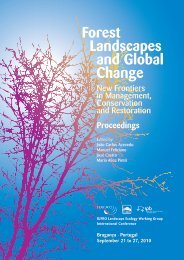Programa e Resumos - I Congresso Ibérico de Ciência do Solo 2004
Programa e Resumos - I Congresso Ibérico de Ciência do Solo 2004
Programa e Resumos - I Congresso Ibérico de Ciência do Solo 2004
You also want an ePaper? Increase the reach of your titles
YUMPU automatically turns print PDFs into web optimized ePapers that Google loves.
I <strong>Congresso</strong> Ibérico da Ciência <strong>do</strong> <strong>Solo</strong> – 15 a 18 <strong>de</strong> Junho <strong>de</strong> <strong>2004</strong>, Bragança, Portugal<br />
Assessment of changes in soil C and N – components, metho<strong>do</strong>logies,<br />
issues and implications<br />
Partap K. Khanna<br />
Institute of Soil Science and Forest Nutrition, Buesgenweg 2, 37077 Goettingen, GERMANY e-<br />
mail address: pkhanna@gwdg.<strong>de</strong><br />
Resumo<br />
Comunicação: Oral<br />
In recent years <strong>de</strong>mands by policy makers to assess changes due to land management<br />
practices in soil organic C (SOC) and N (SON) contents have given a fresh impetus to<br />
un<strong>de</strong>rstand what factors and processes affect such changes and in what way one can<br />
bring about certain <strong>de</strong>sired changes in SOC and SON contents. The primary issues are<br />
related to: changes in greenhouse gases, the productivity levels of ecosystems, adverse<br />
effects on the ground water quality and the maintenance of biological diversity. Most<br />
ecosystems are continually changing in their structure and sometimes in their<br />
functioning, both leading to changes in SOC. This paper will present some of these<br />
issues in terms of their needs and the level of accuracy required for assessing SOC<br />
changes.<br />
SOC and SON occur as multi-component substances and any assessment of change<br />
would need the <strong>de</strong>scription of individual components and their <strong>de</strong>gree of change, the<br />
significance of which requires further consi<strong>de</strong>ration in relation to the natural variability<br />
in the spatial and temporal scales. Components are arbitrarily grouped into two types –<br />
those which are easily and in short term mobilizeable and those which are resistant or<br />
protected and need long time to mobilize, with major consequences on the assessment<br />
metho<strong>do</strong>logy and implications. These are sometimes distinguished by physical (size and<br />
<strong>de</strong>nsity based fractions), chemical (soluble, extractable or to a varying <strong>de</strong>gree<br />
oxidisable), biological (microbial biomass, respiration potential) and biochemical<br />
(lignin, alkyl, phenol and polysacchari<strong>de</strong>s contents). The paper will summarize some of<br />
the essential methods including the use of stable isotopes in terms of their limitations<br />
and usefulness to assess changes in SOC and SON. Quantitative assessment of SOC<br />
and SON requires a reliable estimate of any changes bulk <strong>de</strong>nsity (BD). Do we have a<br />
reliable method of assessing BD of soils<br />
Sources of SOC and SON are primarily related to plant growth (specifically root<br />
growth) whereas minor inputs can be those of agricultural residues and waste materials.<br />
Any retention of C and N by soils will primarily <strong>de</strong>pend upon microbial and faunal<br />
<strong>de</strong>composition activities and soil factors controlling the accessibility (protection factors<br />
– high clay, high Al and Ca, aggregation), retardation (high N, low pH) and acceleration<br />
(priming effects of dissolved OC, low molecular weight organic acids). Commonly<br />
three continuous phases of litter <strong>de</strong>composition are outlined which will be <strong>de</strong>scribed in<br />
terms of their effects on the assessment of SOC changes. There are strong interactions<br />
between SOC and SON and during the discussion on SOC changes, the role of SON is<br />
not a<strong>de</strong>quately consi<strong>de</strong>red. The implications of such interactions will be <strong>de</strong>scribed in<br />
terms of <strong>de</strong>veloping greenhouse gases, and changing productivity, biodiversity and<br />
health of ecosystems.<br />
– 28 –
















